#pitchclassset
Text
Harmonic and Melodic Equivalence V19C
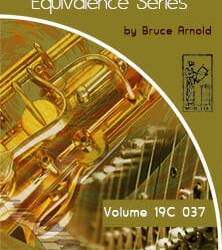
Harmonic and Melodic Equivalence V19C
Get this book for one dollar by using promo code:
buckbook
Harmonic and Melodic Equivalence V19C
Add digital copy to cart - $19.99
Status: In stock, Digital book is available for immediate access.
Melodic Rotations Learning to Improvise More Based on the Composition
"Harmonic and Melodic Equivalence" is a series of books that will help you to develop many different musical skills simultaneously. The source materials for these books are exercises that contain two 3 note groupings, also called "trichords," that are manipulated in various ways. These exercises use many different types of harmonic and melodic ideas that can be superimposed over common chord progressions, scales and other musical situations. The exercises found in these courses are also great for singing and rhythm studies. Finally, the "Harmonic and Melodic Equivalence" course concentrates on the use of the three note pitch class sets (trichords) by pairing each trichord with another trichord with the same prime form. For instance, in this volume C, Eb, G and D, F, A are both 037 pitch class sets because they both contain a minor third and a 5th within their interval structure. This is a great sequence because it uses six notes that are find in any of the major modes therefore you will find a ton of useful applications which are discussed in the course.
Harmonic and Melodic Equivalence Exercises
This course is divided up into two sets of exercises written in treble and bass clef. The 1st set of exercises gets gradually harder but also more musical. Depending upon your musical skills you can start anywhere you want but for beginners I would recommend starting from the 1st exercise of the five. The 2nd set of exercises are called "Atomic Scales." These exercises are a technical exercise that really helps you to learn these ideas but also sound great as a melody right off the bat. There are 6 different types of "Atomic Scales" exercises in this course. You don't have to play every exercise in every key. But doing this will greatly increase the likelihood of you using it in real music in the future. Below is a listing of the exercises found in this course:
Closed position studies.
1st inversion studies.
2nd inversion studies.
Random combinations of closed position along with 1st and 2nd inversion.
Random combinations of closed position along with 1st and 2nd inversion with rhythmic displacement.
Atomic Scales Exercise 1
Atomic Scales Exercise 2
Atomic Scales Exercise 3
Atomic Scales Exercise 4
Atomic Scales Exercise 5
Atomic Scales Exercise 6
Explanation of 2nd Set of Exercises in Harmonic and Melodic Equivalence V19C Course
Below is an explanation for each set of the 6 different atomic scale exercises found in this course. Three octave sequences that move back and forth between the two 3 note groups are presented in six different configurations. These exercises are highly melodic and can be used verbatim as melodies when soloing. If we thought of the three notes as A,B,C then there would be six different ways to combine these notes. i.e. ABC, ACB, BAC, BCA, CAB and CBA. All exercises include MP3s as well as midi files so that you can hear and play these exercises at any tempo as well as versions in all 12 keys.
Three octave sequences that move back and forth between the two 3 note groups in the ABC sequence
Three octave sequences that move back and forth between the two 3 note groups in the ACB sequence
Three octave sequences that move back and forth between the two 3 note groups in the BAC sequence
Three octave sequences that move back and forth between the two 3 note groups in the BCA sequence
Three octave sequences that move back and forth between the two 3 note groups in the CAB sequence
Three octave sequences that move back and forth between the two 3 note groups in the CBA sequence
1st Set of Exercises in Harmonic and Melodic Equivalence V19C Course
Here are a few examples from the 1st set of exercises. A complete list of the different types of exercises can also be found below.
Closed Position Exercise
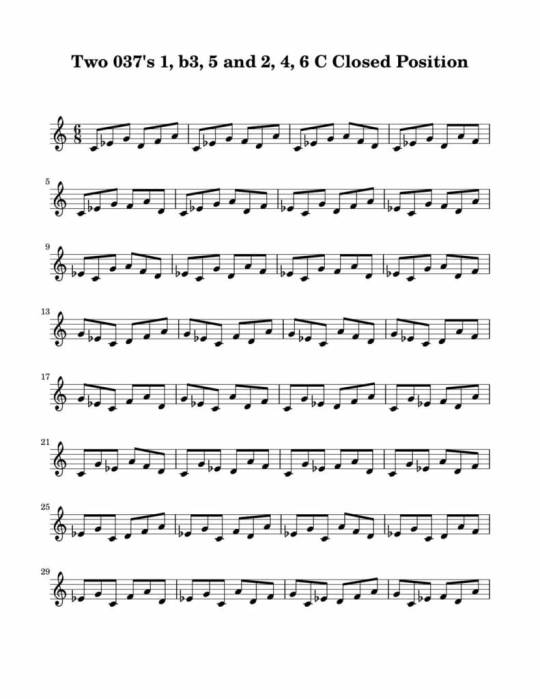
MP3 example
https://s3.amazonaws.com/media.muse-eek.com/mp3/HandME19C/01_037_Degree_1_b3_5_2_4_6_Closed_Position_Key_C.mp3
1st Inversion Exercise
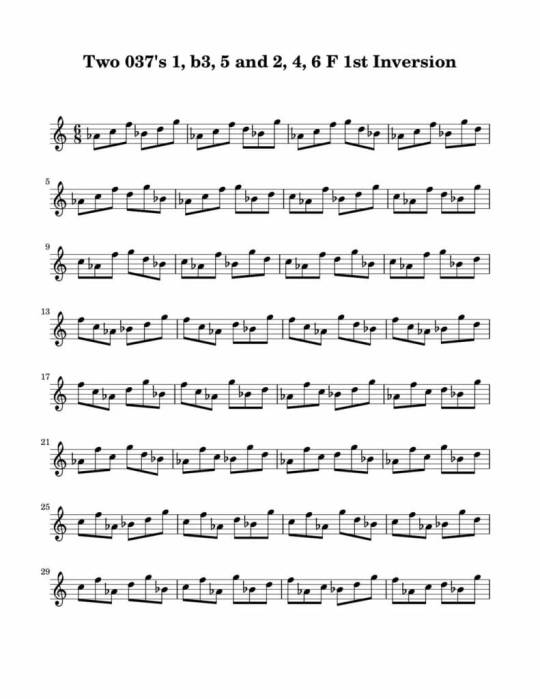
MP3 example
https://s3.amazonaws.com/media.muse-eek.com/mp3/HandME19C/02_037_Degree_1_b3_5_2_4_6_1st_Inversion_Key_F.mp3
2nd Inversion Exercise
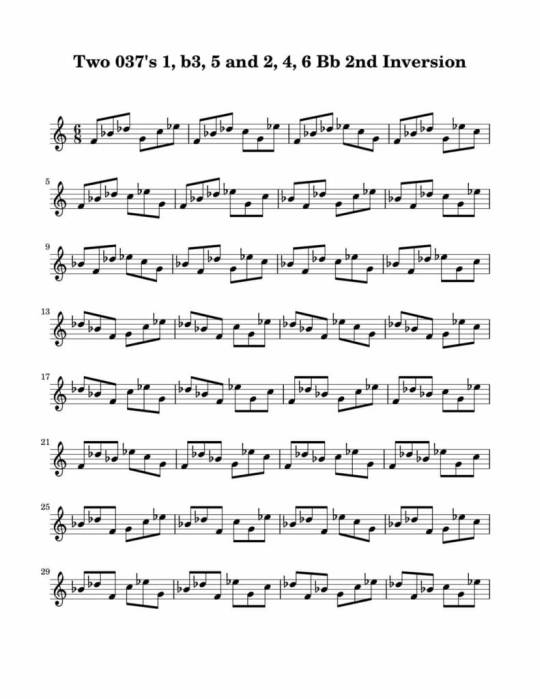
MP3 example
https://s3.amazonaws.com/media.muse-eek.com/mp3/HandME19C/03_037_Degree_1_b3_5_2_4_6_2nd_Inversion_Key_Bb.mp3
Random combinations of closed position along with 1st and 2nd inversion.

MP3 example
https://s3.amazonaws.com/media.muse-eek.com/mp3/HandME19C/04_037_Degree_1_b3_5_2_4_6_Random_Inversions_Key_Eb.mp3
Random combinations of closed position along with 1st and 2nd inversion and rhythm permutation

MP3 example
https://s3.amazonaws.com/media.muse-eek.com/mp3/HandME19C/05_037_Degree_1_3_5_2_b5_6_Random_Inv_Rhy_Key_Ab.mp3
2nd Set of Exercises in Harmonic and Melodic Equivalence V19C Course
Here are a few examples from the 2nd set of exercises.
Atomic Scales 1st Rotation
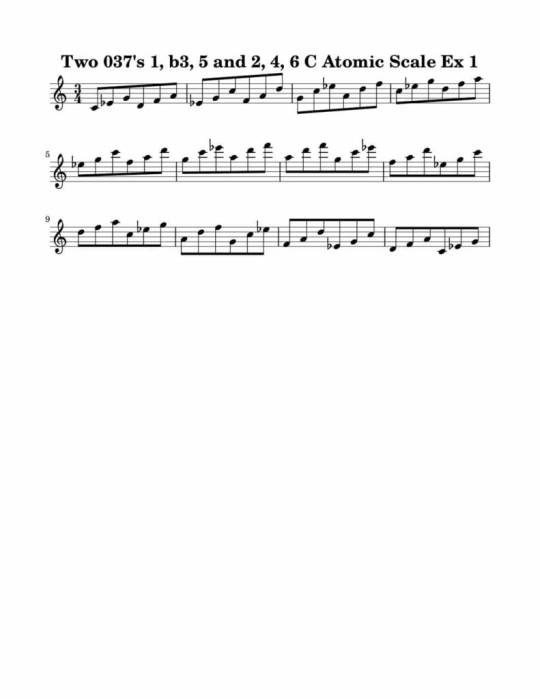
MP3 example
https://s3.amazonaws.com/media.muse-eek.com/mp3/HandME19C/01_037_Degree_1_b3_5_2_4_6_Atomic_Scale_Ex_1_Key_C.mp3
Atomic Scales 2nd Rotation
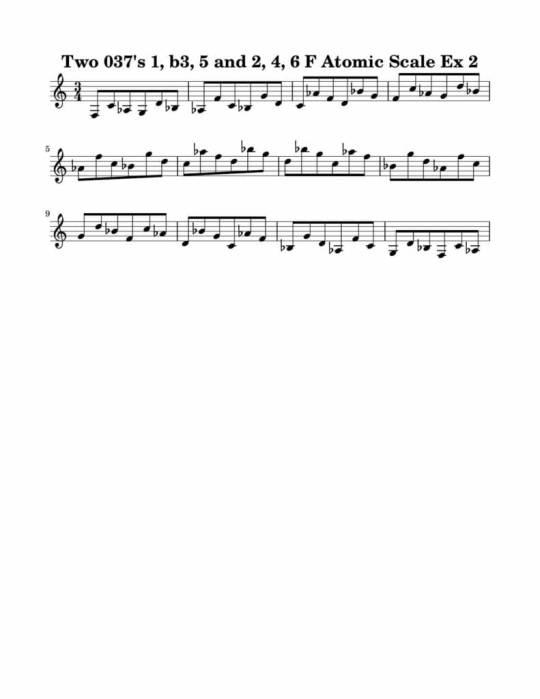
MP3 example
https://s3.amazonaws.com/media.muse-eek.com/mp3/HandME19C/02_037_Degree_1_b3_5_2_4_6_Atomic_Scale_Ex_2_Key_F.mp3
Atomic Scales 3rd Rotation
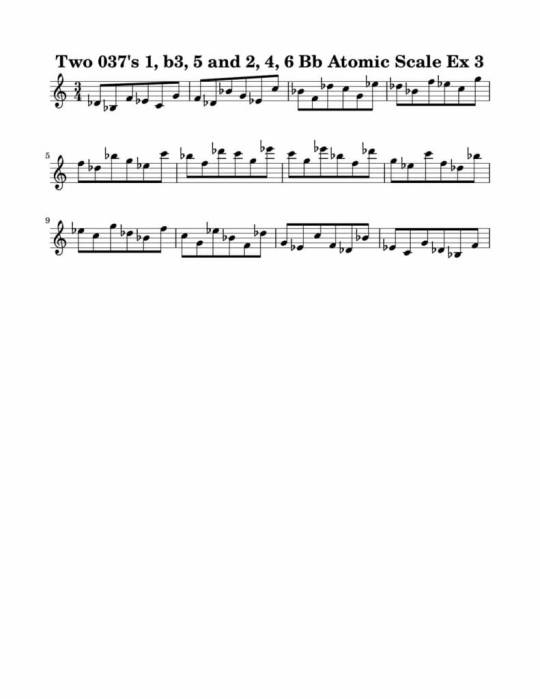
MP3 example
https://s3.amazonaws.com/media.muse-eek.com/mp3/HandME19C/03_037_Degree_1_b3_5_2_4_6_Atomic_Scale_Ex_3_Key_Bb.mp3
Atomic Scales 4th Rotation
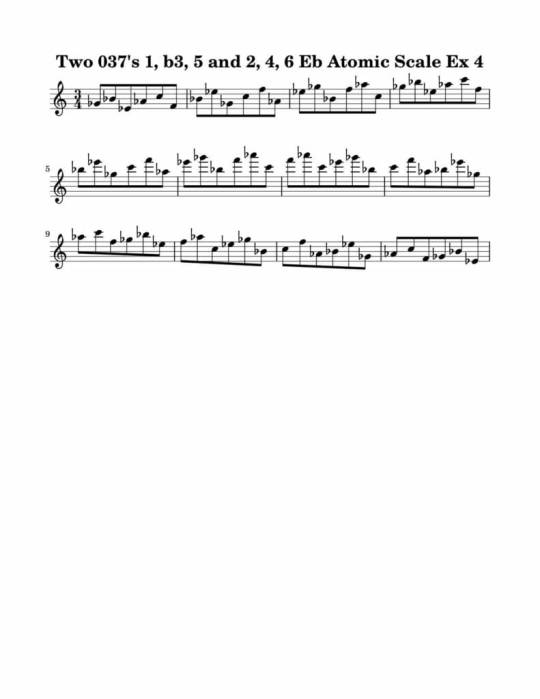
MP3 example
https://s3.amazonaws.com/media.muse-eek.com/mp3/HandME19C/04_037_Degree_1_b3_5_2_4_6_Atomic_Scale_Ex_4_Key_Eb.mp3
Atomic Scales 5th Rotation
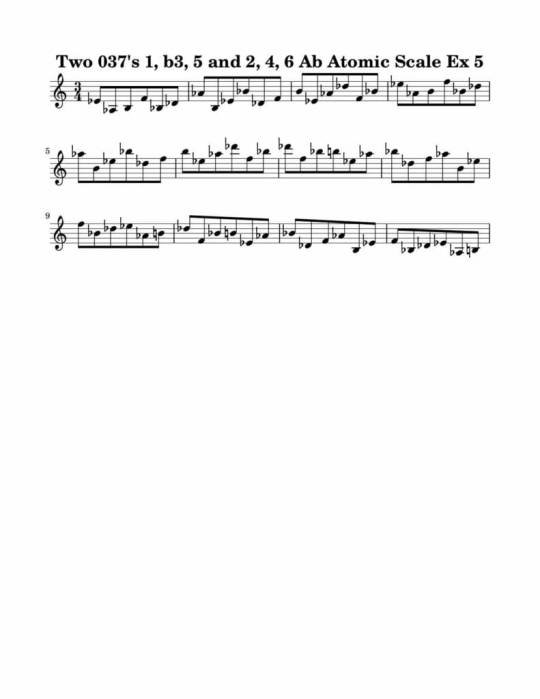
MP3 example
https://s3.amazonaws.com/media.muse-eek.com/mp3/HandME19C/05_037_Degree_1_b3_5_2_4_6_Atomic_Scale_Ex_5_Key_Ab.mp3
Atomic Scales 6th Rotation

MP3 example
https://s3.amazonaws.com/media.muse-eek.com/mp3/HandME19C/06_037_Degree_1_b3_5_2_4_6_Atomic_Scale_Ex_6_Key_Db.mp3
TOC in the Harmonic and Melodic Equivalence V19C Course:
How to Use This Course
Harmonic/Melodic Possibilities of Two 037s
Chord Possibilities of Two 037s
Rotations Starting on Every Eighth Note
Two 037's in Modal Playing
How to Think of the 037s used in this course
037 Daily Exercise-Atomic Scales
Thinking of the Trichords as Modes
Thinking of the Trichords as One Scale
C, Eb, G and D, F, A as One Scale in All Keys
Additional Practice Ideas
Get Harmonic and Melodic Equivalence V19C Today!
Add digital copy to cart - $19.99
Status: In stock, Digital book is available for immediate access.
Additional Information for Harmonic and Melodic Equivalence V19C:
Digital Edition 978-1-59489-339-1
One 11 page PDF explaining exercises, 5 different types of exercises, 328 pages of exercises in PDF format in treble and bass clef
MP3's and Midi files for all exercises.
12 MP3s from Tuba MetroDrone®
What people are saying:
Hey Muse Eek, thanks for including my steady stream of comments on this series. I find the "19" series to be the most helpful in my develop of this idea. Very easy to hear and of course many of these triad pairs show up in common scales that I use so that makes using them easy. J. Ogland
Just wanted to reach out and tell you how much I appreciate you making these books available. I mostly use them for ear training to build my key retention. As you pointed out the Key Retention Builder book is great for building key retention but also singing these exercises shows that different types of melodies create their own set of issues. H. Darwin
Hey Guys really digging this new two minor triad course! Gives me a whole new way to use simple triads to create a very unique and useful sound. A. Gary
Hey Bruce thanks for recommending the singing of these exercises to improve key retention. I'm finding that about half of the 12 keys are totally kicking by behind. I'm really starting to hear that certain melodic combinations pull my ear out of a key center and this is making me very aware of a weak point in my aural skills B. Bolton
Read the full article
#DoubleMambo#improvisation#pitchclassset#12tone#rotations#CharlieBanacos#pitchclasssetsoloingideas#HarmonicandMelodicEquivalenceV19C
0 notes
Text
Harmonic and Melodic Equivalence V19B
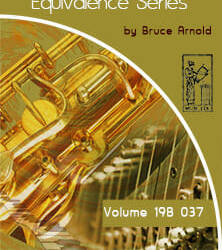
Harmonic and Melodic Equivalence V19B
Get it for one dollar with promo code:
buckbook
Harmonic and Melodic Equivalence V19B
Add digital copy to cart - $19.99
Status: In stock, Digital book is available for immediate access.
Melodic Rotations Learning to Improvise More Based on the Composition
"Harmonic and Melodic Equivalence" is a series of books that will help you to develop many different musical skills simultaneously. The source materials for these books are exercises that contain two 3 note groupings, also called "trichords," that are manipulated in various ways. These exercises use many different types of harmonic and melodic ideas that can be superimposed over common chord progressions, scales and other musical situations. The exercises found in these courses are also great for singing and rhythm studies. Finally, the "Harmonic and Melodic Equivalence" course concentrates on the use of the three note pitch class sets (trichords) by pairing each trichord with another trichord with the same prime form. For instance, in this volume C, E, G and D, F#, A are both 037 pitch class sets because they both contain a major third and a 5th within their interval structure. This is a great sequence because it uses six notes that are find in any of the major modes therefore you will find a ton of useful applications which are discussed in the course.
Harmonic and Melodic Equivalence Exercises
This course is divided up into two sets of exercises written in treble and bass clef. The 1st set of exercises gets gradually harder but also more musical. Depending upon your musical skills you can start anywhere you want but for beginners I would recommend starting from the 1st exercise of the five. The 2nd set of exercises are called "Atomic Scales." These exercises are a technical exercise that really helps you to learn these ideas but also sound great as a melody right off the bat. There are 6 different types of "Atomic Scales" exercises in this course. You don't have to play every exercise in every key. But doing this will greatly increase the likelihood of you using it in real music in the future. Below is a listing of the exercises found in this course:
Closed position studies.
1st inversion studies.
2nd inversion studies.
Random combinations of closed position along with 1st and 2nd inversion.
Random combinations of closed position along with 1st and 2nd inversion with rhythmic displacement.
Atomic Scales Exercise 1
Atomic Scales Exercise 2
Atomic Scales Exercise 3
Atomic Scales Exercise 4
Atomic Scales Exercise 5
Atomic Scales Exercise 6
Explanation of 2nd Set of Exercises in Harmonic and Melodic Equivalence V19B Course
Below is an explanation for each set of the 6 different atomic scale exercises found in this course. Three octave sequences that move back and forth between the two 3 note groups are presented in six different configurations. These exercises are highly melodic and can be used verbatim as melodies when soloing. If we thought of the three notes as A,B,C then there would be six different ways to combine these notes. i.e. ABC, ACB, BAC, BCA, CAB and CBA. All exercises include MP3s as well as midi files so that you can hear and play these exercises at any tempo as well as versions in all 12 keys.
Three octave sequences that move back and forth between the two 3 note groups in the ABC sequence
Three octave sequences that move back and forth between the two 3 note groups in the ACB sequence
Three octave sequences that move back and forth between the two 3 note groups in the BAC sequence
Three octave sequences that move back and forth between the two 3 note groups in the BCA sequence
Three octave sequences that move back and forth between the two 3 note groups in the CAB sequence
Three octave sequences that move back and forth between the two 3 note groups in the CBA sequence
1st Set of Exercises in Harmonic and Melodic Equivalence V19B Course
Here are a few examples from the 1st set of exercises. A complete list of the different types of exercises can also be found below.
Closed Position Exercise

MP3 example
https://s3.amazonaws.com/media.muse-eek.com/mp3/HandMEV19B/01_037_Degree_1_3_5_2_b5_6_Closed_Position_Key_C.mp3
1st Inversion Exercise
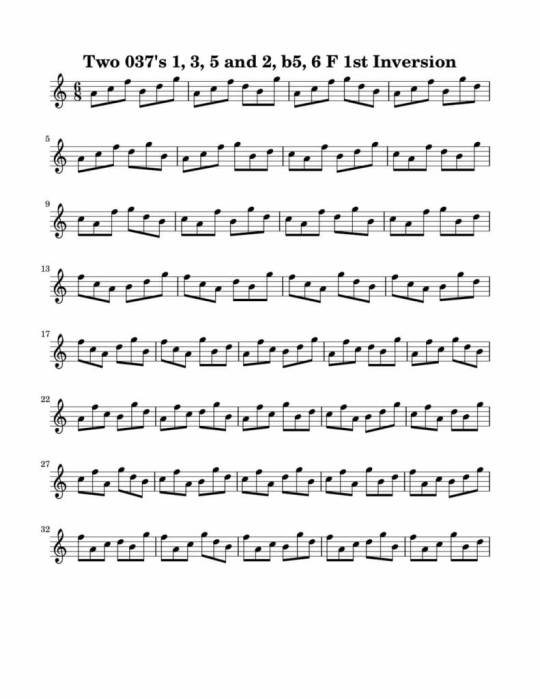
MP3 example
https://s3.amazonaws.com/media.muse-eek.com/mp3/HandMEV19B/02_037_Degree_1_3_5_2_b5_6_1st_Inversion_Key_F.mp3
2nd Inversion Exercise
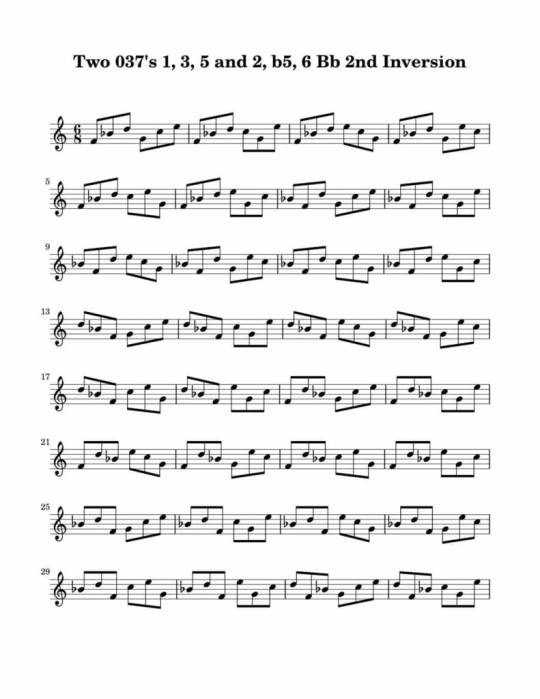
MP3 example
https://s3.amazonaws.com/media.muse-eek.com/mp3/HandMEV19B/03_037_Degree_1_3_5_2_b5_6_2nd_Inversion_Key_Bb.mp3
Random combinations of closed position along with 1st and 2nd inversion.

MP3 example
https://s3.amazonaws.com/media.muse-eek.com/mp3/HandMEV19B/04_037_Degree_1_3_5_2_b5_6_Random_Inversions_Key_Eb.mp3
Random combinations of closed position along with 1st and 2nd inversion and rhythm permutation

MP3 example
https://s3.amazonaws.com/media.muse-eek.com/mp3/HandMEV19B/05_037_Degree_1_3_5_2_b5_6_Random_Inv_Rhy_Key_Ab.mp3
2nd Set of Exercises in Harmonic and Melodic Equivalence V19B Course
Here are a few examples from the 2nd set of exercises.
Atomic Scales 1st Rotation
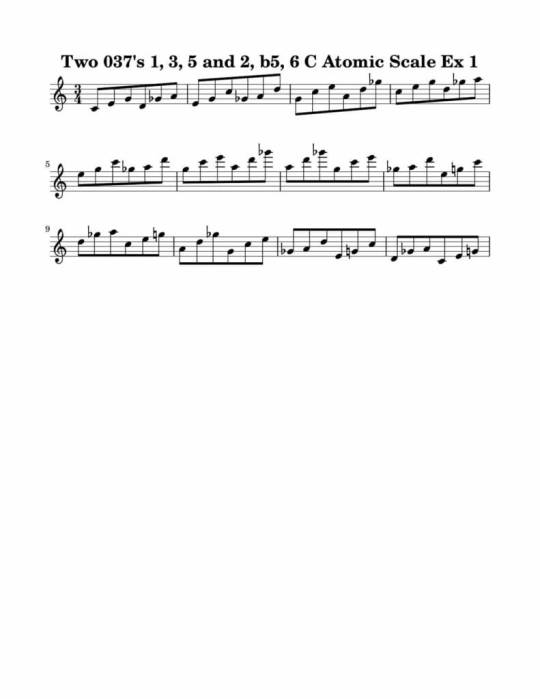
MP3 example
https://s3.amazonaws.com/media.muse-eek.com/mp3/HandMEV19B/01_037_Degree_1_3_5_2_b5_6_Atomic_Scale_Ex_1_Key_C.mp3
Atomic Scales 2nd Rotation
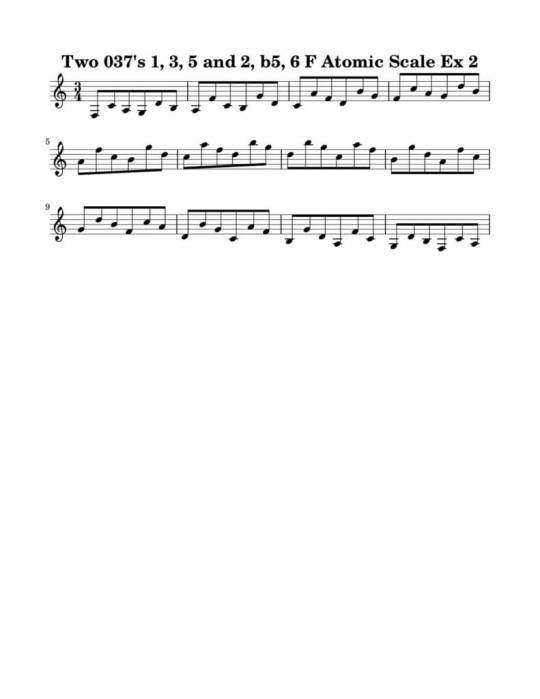
MP3 example
https://s3.amazonaws.com/media.muse-eek.com/mp3/HandMEV19B/02_037_Degree_1_3_5_2_b5_6_Atomic_Scale_Ex_2_Key_F.mp3
Atomic Scales 3rd Rotation
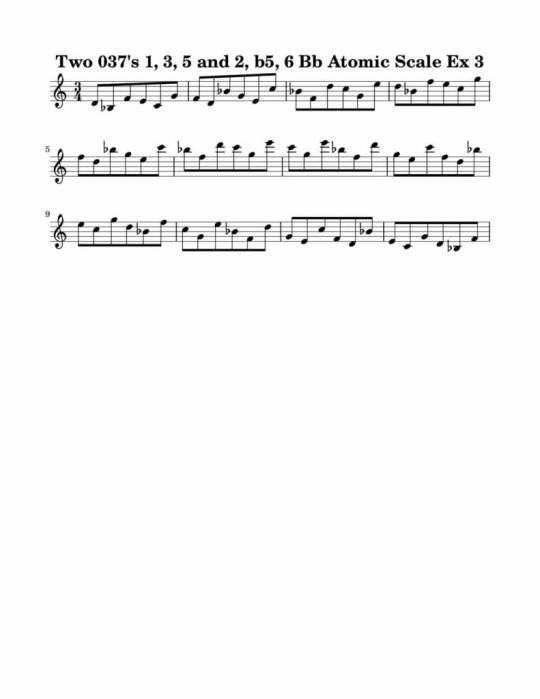
MP3 example
https://s3.amazonaws.com/media.muse-eek.com/mp3/HandMEV19B/03_037_Degree_1_3_5_2_b5_6_Atomic_Scale_Ex_3_Key_Bb.mp3
Atomic Scales 4th Rotation

MP3 example
https://s3.amazonaws.com/media.muse-eek.com/mp3/HandMEV19B/04_037_Degree_1_3_5_2_b5_6_Atomic_Scale_Ex_4_Key_Eb.mp3
Atomic Scales 5th Rotation
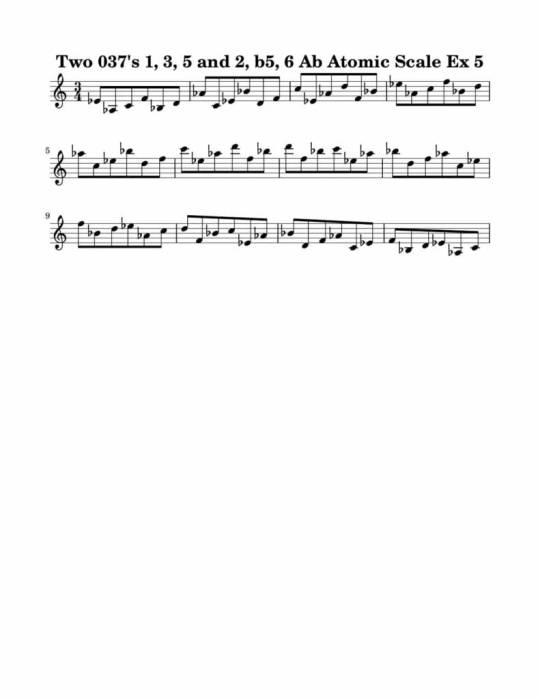
MP3 example
https://s3.amazonaws.com/media.muse-eek.com/mp3/HandMEV19B/05_037_Degree_1_3_5_2_b5_6_Atomic_Scale_Ex_5_Key_Ab.mp3
Atomic Scales 6th Rotation

MP3 example
https://s3.amazonaws.com/media.muse-eek.com/mp3/HandMEV19B/06_037_Degree_1_3_5_2_b5_6_Atomic_Scale_Ex_6_Key_Db.mp3
TOC in the Harmonic and Melodic Equivalence V19B Course:
How to Use This Course
Harmonic/Melodic Possibilities of Two 037s
Chord Possibilities of Two 037s
Rotations Starting on Every Eighth Note
Two 037's in Modal Playing
How to Think of the 037s Used in This Course
037 Daily Exercise-Atomic Scales
Thinking of the Trichords as Modes
Thinking of the Trichords as One Scale
C, E, G and D, F#, A as One Scale in All Keys
Additional Practice Ideas
Get Harmonic and Melodic Equivalence V19B Today!
Add digital copy to cart - $19.99
Status: In stock, Digital book is available for immediate access.
Additional Information for Harmonic and Melodic Equivalence V19B:
Digital Edition 978-1-59489-338-4
One 11 page PDF explaining exercises, 5 different types of exercises, 328 pages of exercises in PDF format in treble and bass clef
MP3's and Midi files for all exercises.
12 MP3s from Tuba MetroDrone®
What people are saying:
Wow the original Charlie Banacos "Double Mambo" concept. I see why Mr. Arnold got so excited about this sound when he was introduced to it. Super hip and can be used is so many ways! J. Ogland
Thanks Bruce, this is a must own volume in the series. Such a strong and unique sound with the two major triads. If it's good enough for McCoy Tyner then it's good enough for me! K. Edwards
Bruce I just wanted to give a shout out on this new Harmonic and Melodic Equivalence V19B course. What a cool sound these two triads make! Appreciate all the work you put into it. E. Greig
Hey Muse Eek just wanted to give you my 2 cents on this new course. First the "Atomic Scales" exercise is really helping me get these ideas under my fingers. Also thanks for pointing out how Tyner's "Passion Dance" is totally derived from this sound. Listen to that track has been very inspiring. J. Samuels
Read the full article
#DoubleMambo#improvisation#pitchclassset#12tone#McCoyTyner#rotations#soloingideas#HarmonicandMelodicEquivalenceV19B#CharlieBanacos#McCoyTynerPassionDance
0 notes
Text
Harmonic and Melodic Equivalence V21A

Harmonic and Melodic Equivalence V21A
Book is now on sale for One Dollar use promo code:
buckbook
Harmonic and Melodic Equivalence V21A
Add digital copy to cart - $19.99
Status: In stock, Digital book is available for immediate access.
Melodic Rotations Learning to Improvise More Based on the Composition
"Harmonic and Melodic Equivalence" is a series of books that will help you to develop many different musical skills simultaneously. The source materials for these books are exercises that contain two 3 note groupings, also called "trichords," that are manipulated in various ways. These exercises use many different types of harmonic and melodic ideas that can be superimposed over common chord progressions, scales and other musical situations. The exercises found in these courses are also great for singing and rhythm studies. Finally, the "Harmonic and Melodic Equivalence" course concentrates on the use of the three note pitch class sets (trichords) by pairing each trichord with another trichord with the same prime form. For instance, in this volume a Blues scale is divided up into two 3 note segments. Various exercises are presented that help you master this idea and examples can be seen below. This is an excellent way to get some new ideas from an old yet great scale.
Harmonic and Melodic Equivalence Exercises
This course is divided up into two sets of exercises written in treble and bass clef. The 1st set of exercises gets gradually harder but also more musical. Depending upon your musical skills you can start anywhere you want but for beginners I would recommend starting from the 1st exercise of the five. The 2nd set of exercises are called "Atomic Scales." These exercises are a technical exercise that really helps you to learn these ideas but also sound great as a melody right off the bat. There are 6 different types of "Atomic Scales" exercises in this course. You don't have to play every exercise in every key. But doing this will greatly increase the likelihood of you using it in real music in the future. Below is a listing of the exercises found in this course:
Closed position studies.
1st inversion studies.
2nd inversion studies.
Random combinations of closed position along with 1st and 2nd inversion.
Random combinations of closed position along with 1st and 2nd inversion with rhythmic displacement.
Atomic Scales Exercise 1
Atomic Scales Exercise 2
Atomic Scales Exercise 3
Atomic Scales Exercise 4
Atomic Scales Exercise 5
Atomic Scales Exercise 6
Explanation of 1st Set of Exercises in Harmonic and Melodic Equivalence V21A Course
Below is an explanation for each set of the 6 different atomic scale exercises found in this course. Three octave sequences that move back and forth between the two 3 note groups are presented in six different configurations. These exercises are highly melodic and can be used verbatim as melodies when soloing. If we thought of the three notes as A,B,C then there would be six different ways to combine these notes. i.e. ABC, ACB, BAC, BCA, CAB and CBA. All exercises include MP3s as well as midi files so that you can hear and play these exercises at any tempo as well as versions in all 12 keys.
Three octave sequences that move back and forth between the two 3 note groups in the ABC sequence
Three octave sequences that move back and forth between the two 3 note groups in the ACB sequence
Three octave sequences that move back and forth between the two 3 note groups in the BAC sequence
Three octave sequences that move back and forth between the two 3 note groups in the BCA sequence
Three octave sequences that move back and forth between the two 3 note groups in the CAB sequence
Three octave sequences that move back and forth between the two 3 note groups in the CBA sequence
1st Set of Exercises in Harmonic and Melodic Equivalence V21A Course
Here are a few examples from the 1st set of exercises. A complete list of the different types of exercises can also be found below.
Closed Position Exercise

MP3 example
https://s3.amazonaws.com/media.muse-eek.com/mp3/HandMEV21A/01_Blues-016-027_Closed_Position_Key_C.mp3
1st Inversion Exercise

MP3 example
https://s3.amazonaws.com/media.muse-eek.com/mp3/HandMEV21A/02_Blues-016-027_1st_Inversion_Key_F.mp3
2nd Inversion Exercise

MP3 example
https://s3.amazonaws.com/media.muse-eek.com/mp3/HandMEV21A/03_Blues-016-027_2nd_Inversion_Key_Bb.mp3
Random combinations of closed position along with 1st and 2nd inversion.

MP3 example
https://s3.amazonaws.com/media.muse-eek.com/mp3/HandMEV21A/04_Blues-016-027_Random_Inversions_Key_Eb.mp3
Random combinations of closed position along with 1st and 2nd inversion and rhythm permutation

MP3 example
https://s3.amazonaws.com/media.muse-eek.com/mp3/HandMEV21A/05_Blues-016-027_Random_Inv_Rhy_Key_Ab.mp3
2nd Set of Exercises in Harmonic and Melodic Equivalence V21A Course
Here are a few examples from the 2nd set of exercises.
Atomic Scales 1st Rotation

MP3 example
https://s3.amazonaws.com/media.muse-eek.com/mp3/HandMEV21A/01_Blues-016-027_Atomic_Scale_Ex_1_Key_C.mp3
Atomic Scales 2nd Rotation

MP3 example
https://s3.amazonaws.com/media.muse-eek.com/mp3/HandMEV21A/02_Blues-016-027_Atomic_Scale_Ex_2_Key_F.mp3
Atomic Scales 3rd Rotation

MP3 example
https://s3.amazonaws.com/media.muse-eek.com/mp3/HandMEV21A/03_Blues-016-027_Atomic_Scale_Ex_3_Key_Bb.mp3
Atomic Scales 4th Rotation

MP3 example
https://s3.amazonaws.com/media.muse-eek.com/mp3/HandMEV21A/04_Blues-016-027_Atomic_Scale_Ex_4_Key_Eb.mp3
Atomic Scales 5th Rotation

MP3 example
https://s3.amazonaws.com/media.muse-eek.com/mp3/HandMEV21A/05_Blues-016-027_Atomic_Scale_Ex_5_Key_Ab.mp3
Atomic Scales 6th Rotation

MP3 example
https://s3.amazonaws.com/media.muse-eek.com/mp3/HandMEV21A/06_Blues-016-027_Atomic_Scale_Ex_6_Key_Db.mp3
TOC in the Harmonic and Melodic Equivalence V21A Course:
How to Use This Course
Harmonic/Melodic Possibilities of 016-027
Chord Possibilities of 016-027
Using 016-027 and its Complement in a Solo Blues Composition
016-027 Solo Blues Composition
016-027 Relationships in all Keys to Common Scales
Thinking of the Trichords as One Scale
C, F#, G and Eb, F, Bb Minus the Chromatic Pitch
Get Harmonic and Melodic Equivalence V21A Today!
Add digital copy to cart - $19.99
Status: In stock, Digital book is available for immediate access.
Additional Information for Harmonic and Melodic Equivalence V21A:
Digital Edition 978-1-59489-335-3
One 8 page PDF explaining exercises, 5 different types of exercises, 328 pages of exercises in PDF format in treble and bass clef
MP3's and Midi files for all exercises.
12 MP3s from Tuba MetroDrone®
What people are saying:
Hey Bruce, this is a very cool application of a Blues Scale. I really enjoy all the information you have provided on alternate ways to use and think of the Blues scale. This is immediately useful information J. Ogland
I'm a Blues guy and this is really turning my head around. Such cool ideas in this book about how to split up a Blues scale but also how to use that split to form chord progressions. Thanks for all this mind bending stuff. W. Drews
Boy Bruce this course really knocks it out of the park. These "Atomic Scale" exercises using a Blues scale are awesome! I also appreciate your suggestion to start adding embellishments like bends and slides into the exercises. That really gives me to sound I'm striving for. J. Greig
Really a 21st century approach to an age old scale. Really digging the concept! T. Karen
Read the full article
#improvisation#pitchclassset#blues#12tone#Bluesscale#MelodicRotations#HarmonicandMelodicEquivalenceV21A#Blueshexatonic
0 notes
Text
Harmonic and Melodic Equivalence V19A
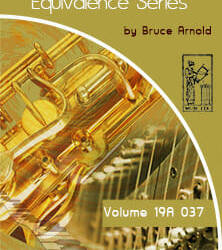
Harmonic and Melodic Equivalence V19A
Buy now for 1.00 USD
Promo code: buckbook
Harmonic and Melodic Equivalence V19A
Add digital copy to cart - $19.99
Status: In stock, Digital book is available for immediate access.
Melodic Rotations Learning to Improvise More Based on the Composition
"Harmonic and Melodic Equivalence" is a series of books that will help you to develop many different musical skills simultaneously. The source materials for these books are exercises that contain two 3 note groupings, also called "trichords," that are manipulated in various ways. These exercises use many different types of harmonic and melodic ideas that can be superimposed over common chord progressions, scales and other musical situations. The exercises found in these courses are also great for singing and rhythm studies. Finally, the "Harmonic and Melodic Equivalence" course concentrates on the use of the three note pitch class sets (trichords) by pairing each trichord with another trichord with the same prime form. For instance, in this volume C, Db, Eb and F#, G, A are both 013 pitch class sets because they both contain a 1/2 step and a minor 3rd within their interval structure. This is a great sequence because it uses six notes from a symmetrical diminished scale therefore you will find a ton of useful applications which are discussed in the course.
Harmonic and Melodic Equivalence Exercises
This course is divided up into two sets of exercises written in treble and bass clef. The 1st set of exercises gets gradually harder but also more musical. Depending upon your musical skills you can start anywhere you want but for beginners I would recommend starting from the 1st exercise of the five. The 2nd set of exercises are called "Atomic Scales." These exercises are a technical exercise that really helps you to learn these ideas but also sound great as a melody right off the bat. There are 6 different types of "Atomic Scales" exercises in this course. You don't have to play every exercise in every key. But doing this will greatly increase the likelihood of you using it in real music in the future. Below is a listing of the exercises found in this course:
Closed position studies.
1st inversion studies.
2nd inversion studies.
Random combinations of closed position along with 1st and 2nd inversion.
Random combinations of closed position along with 1st and 2nd inversion with rhythmic displacement.
Atomic Scales Exercise 1
Atomic Scales Exercise 2
Atomic Scales Exercise 3
Atomic Scales Exercise 4
Atomic Scales Exercise 5
Atomic Scales Exercise 6
Explanation of 1st Set of Exercises in Harmonic and Melodic Equivalence V19A Course
Below is an explanation for each set of the 6 different atomic scale exercises found in this course. Three octave sequences that move back and forth between the two 3 note groups are presented in six different configurations. These exercises are highly melodic and can be used verbatim as melodies when soloing. If we thought of the three notes as A,B,C then there would be six different ways to combine these notes. i.e. ABC, ACB, BAC, BCA, CAB and CBA. All exercises include MP3s as well as midi files so that you can hear and play these exercises at any tempo as well as versions in all 12 keys.
Three octave sequences that move back and forth between the two 3 note groups in the ABC sequence
Three octave sequences that move back and forth between the two 3 note groups in the ACB sequence
Three octave sequences that move back and forth between the two 3 note groups in the BAC sequence
Three octave sequences that move back and forth between the two 3 note groups in the BCA sequence
Three octave sequences that move back and forth between the two 3 note groups in the CAB sequence
Three octave sequences that move back and forth between the two 3 note groups in the CBA sequence
1st Set of Exercises in Harmonic and Melodic Equivalence V19A Course
Here are a few examples from the 1st set of exercises. A complete list of the different types of exercises can also be found below.
Closed Position Exercise
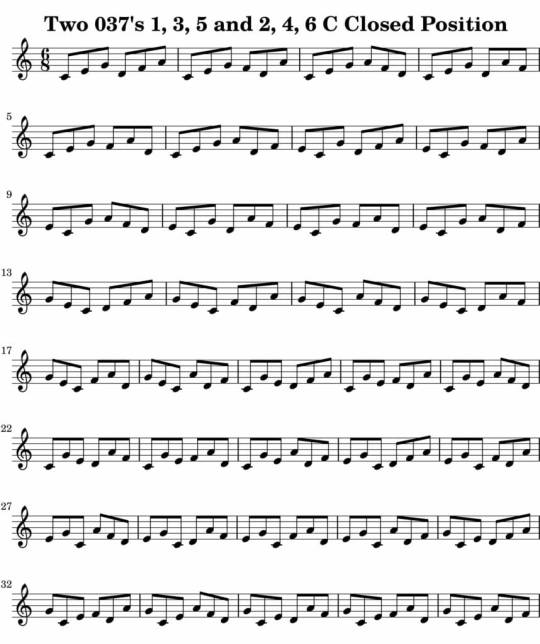
MP3 example
https://s3.amazonaws.com/media.muse-eek.com/mp3/HandMEV19A/01_037_Degree_1_3_5_2_4_6_Closed_Position_Key_C.mp3
1st Inversion Exercise
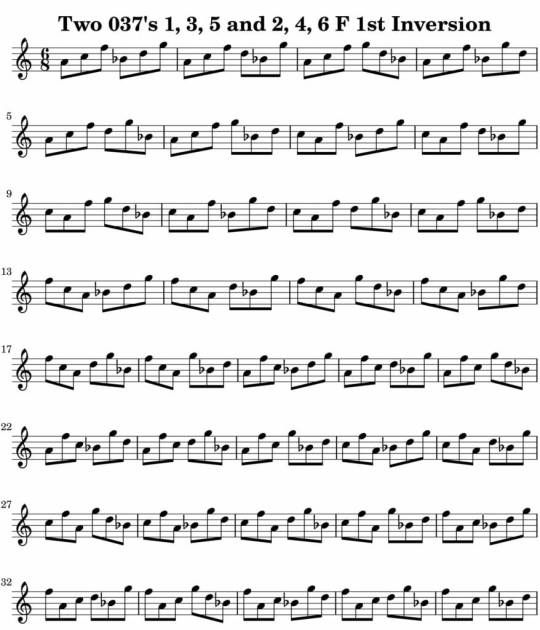
MP3 example
https://s3.amazonaws.com/media.muse-eek.com/mp3/HandMEV19A/02_037_Degree_1_3_5_2_4_6_1st_Inversion_Key_F.mp3
2nd Inversion Exercise

MP3 example
https://s3.amazonaws.com/media.muse-eek.com/mp3/HandMEV19A/03_037_Degree_1_3_5_2_4_6_2nd_Inversion_Key_Bb.mp3
Random combinations of closed position along with 1st and 2nd inversion.
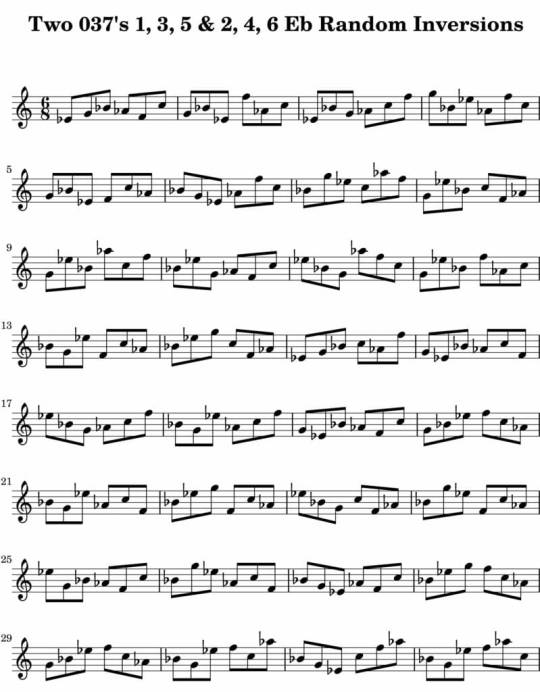
MP3 example
https://s3.amazonaws.com/media.muse-eek.com/mp3/HandMEV19A/04_037_Degree_1_3_5_2_4_6_Random_Inversions_Key_Eb.mp3
Random combinations of closed position along with 1st and 2nd inversion and rhythm permutation
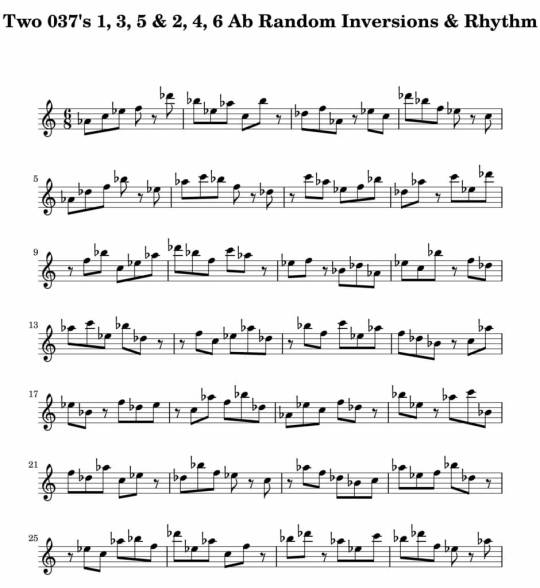
MP3 example
https://s3.amazonaws.com/media.muse-eek.com/mp3/HandMEV19A/05_037_Degree_1_3_5_2_4_6_Random_Inv_Rhy_Key_Ab.mp3
2nd Set of Exercises in Harmonic and Melodic Equivalence V19A Course
Here are a few examples from the 2nd set of exercises.
Atomic Scales 1st Rotation
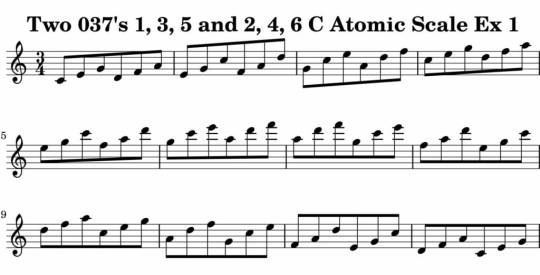
MP3 example
https://s3.amazonaws.com/media.muse-eek.com/mp3/HandMEV19A/01_037_Degree_1_3_5_2_4_6_Atomic_Scale_Ex_1_Key_C.mp3
Atomic Scales 2nd Rotation
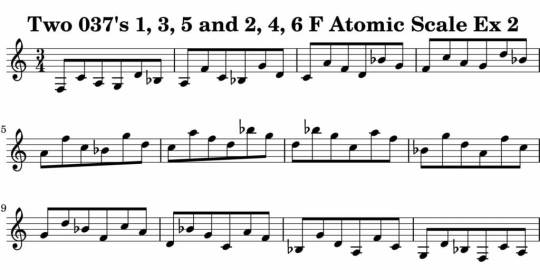
MP3 example
https://s3.amazonaws.com/media.muse-eek.com/mp3/HandMEV19A/02_037_Degree_1_3_5_2_4_6_Atomic_Scale_Ex_2_Key_F.mp3
Atomic Scales 3rd Rotation
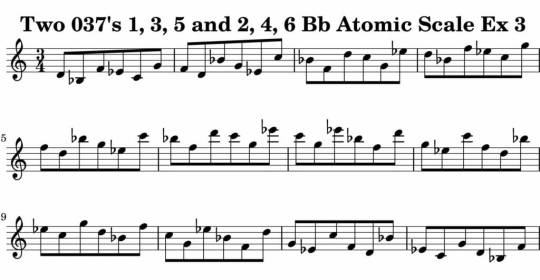
MP3 example
https://s3.amazonaws.com/media.muse-eek.com/mp3/HandMEV19A/03_037_Degree_1_3_5_2_4_6_Atomic_Scale_Ex_3_Key_Bb.mp3
Atomic Scales 4th Rotation
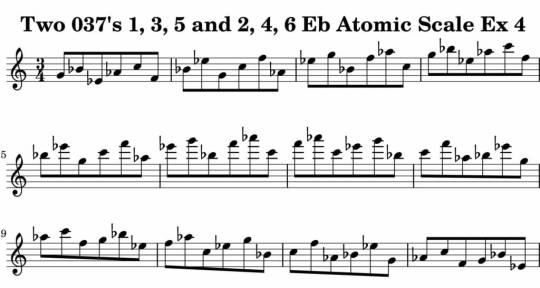
MP3 example
https://s3.amazonaws.com/media.muse-eek.com/mp3/HandMEV19A/04_037_Degree_1_3_5_2_4_6_Atomic_Scale_Ex_4_Key_Eb.mp3
Atomic Scales 5th Rotation
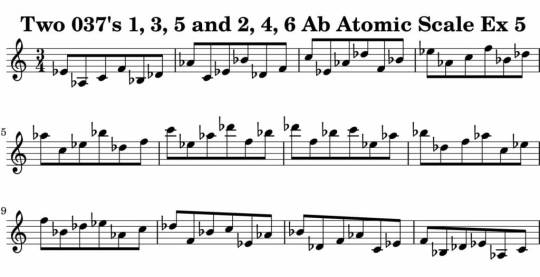
MP3 example
https://s3.amazonaws.com/media.muse-eek.com/mp3/HandMEV19A/05_037_Degree_1_3_5_2_4_6_Atomic_Scale_Ex_5_Key_Ab.mp3
Atomic Scales 6th Rotation

MP3 example
https://s3.amazonaws.com/media.muse-eek.com/mp3/HandMEV19A/06_037_Degree_1_3_5_2_4_6_Atomic_Scale_Ex_6_Key_Db.mp3
TOC in the Harmonic and Melodic Equivalence V19A Course:
How to Use This Course
Harmonic/Melodic Possibilities of Two 037's
Chord Possibilities of Two 037's
Rotations Starting on Every Eighth Note
Two 013's in Modal Playing
How to Think of the 013's Used in This Course
013 Daily Exercise-Atomic Scales
Thinking of the Trichords as Modes
Thinking of the Trichords as One Scale
C, E, G and D, F, A as One Scale in All Keys
Get Harmonic and Melodic Equivalence V19A Today!
Add digital copy to cart - $19.99
Status: In stock, Digital book is available for immediate access.
Additional Information for Harmonic and Melodic Equivalence V19A:
Digital Edition 978-1-59489-334-6
One 8 page PDF explaining exercises, 5 different types of exercises, 328 pages of exercises in PDF format in treble and bass clef
MP3's and Midi files for all exercises.
12 MP3s from Tuba MetroDrone®
What people are saying:
OK I'm a big fan of the band "Weather Report" and these two triad things are exactly what Joe Zawinal is doing during his improvisation...among other things of course. This is a great study Bruce! Thanks for pointing it out to me and showing me some places where it is used J. Ogland
I've been following your "Harmonic and Melodic Equivalence Series" and this volume is what sold me on the idea. There are some really cool melodies here that you can combine with pentatonics or blues. Thanks for making the course! R. Andersen
Hey just wanted to give you a shout out that I'm digging the atomic scales in these courses. That is an awesome technique that I can directly translate to my soloing. A. Newburg
Such a cool series Bruce. Thanks for creating these and making so many of these examples available on line K. Wilkes
Read the full article
0 notes
Text
Scale Analysis
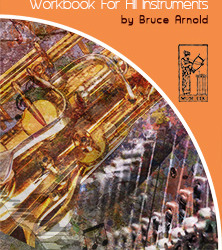
Scale Analysis
Scale Analysis is a mega course that melds your aural comprehension with your intellectual understanding of scales, keys and chords into one unified whole.Scale-Analysis-by-Bruce-Arnold-muse-eek.com700 Page PDF, 36 Videos: Over 4 hours of video, 108 MP3s and 72 Midifiles.Add digital copy to cart - $69.99
Scale Analysis
Scale Analysis is hands down the most comprehensive course on the subject of ear training and how it applies to hearing chord progressions and scales. It will teach you to hear multiple scales and chords all within a key center. This skill will revolutionize your improvisations and compositions and change your whole approach when working with chords and scales.Please Note: We recommend that all guitarist work with the Guitar Technique and Physiology Course so that you learn with proper scale technique. This course gives you a comprehensive approach to playing guitar and includes a videos on all aspects of guitar technique.
Overarching Goal
As stated, the overarching goal behind the Scale Analysis course is to teach you how to hear multiple chords all in one key center. By honing this ability you will find improvising over chords to be much simpler and more musical at the same time. Initially, this course presents a way to understand how you should hear chords and their associated chord scales. Secondly, it develops your ear so that you are truly hearing and playing using these concepts.
The Key is the Key
This idea of hearing entire chord progressions within a key center is not new. Take a look at any jazz standard or pop tune and you will find a melody that is largely diatonic to a key center while multiple chords are present. Unfortunately, most educational systems use a cookie cutter approach to understanding and playing over chord changes, wherein each chord is its own key center. In other words, the root of each chord is thought of as the new key center.
Simplify but at the same time Expand Your Improvisation
This concept of playing leads to a very vertical conception of “playing over the changes” and makes creating a key-based, melodic solo very difficult, if not impossible. This vertical approach also goes against how you ultimately hear music and will become apparent as your ear progresses with the “Contextual Ear Training” courses that I’ve created. Working with "Scale Analysis" will speed up your ability to hear scales and chords in one key center. Targeted exercises instill both an intellectual understanding of these musical elements, as well as strengthening your aural skills so that you actually start to hear the correct way.
Each Chord influences the Next Chord
The second major premise is that when you have multiple chords within a chord progression each successive chord and the scale chosen for that chord will affect which scale you use for the next chord. This is because your ear tends to want to hold on to any sound it hears until it is canceled out by another sound. This canceling sound is usually a chord tone on the next chord. A quick example: If you have a C Dominant 7th chord and you play a C Mixolydian scale over it, if you then hear an F7 chord the “Eb” in the F7 chord will cancel out the “E” in the Mixolydian scale, creating a C Dorian scale. So you can see that we are thinking of both chords in the key of C.
Example of Chord Following Chord
There will of course be exceptions to this; for example, if you play the C Dominant chord for a couple of measures and then play the F7 chord for eight measure at some point you stand a good chance of modulating to the key of F. This is completely fine! The idea is that the longer you hear a chord the more chances you have to modulate to the root of that chord. And the faster the chords are presented, the more you stand the chance of hearing all the chords in one key center. In most cases musicians need work on hearing a group of chords and their chord scales in one key center and that is the backbone of this course.
Additional Information Found in This Course
The above video gives you examples of different parts of the book, but besides the worksheet where you write out the scales, there are many other aspects of the course that give you extremely valuable information about chord scale relationships, such as:A list showing you which chords tend to be used with specific scales when you relate them to one key center.A index showing you the location of the scales and their related chords within 36 chord progressions so you can see patterns.A list showing you all possible chord scale relationships for each scale used in the 36 chord progressions.A index showing you all possible subsets for the scales used in the chord progressions.A list showing the South Indian “Melakarta” scales and their relationship to the scales used in this course.A index of all alternate names used for the scales found in this course.Additional ear training exercises which help you apply the techniques you have learned to popular tunes or your own compositions.
Dig Deeper into Scale Analysis
"Scale Analysis" covers the subsets for 109 scales. These subsets are very useful for applying other techniques of improvisation, instead of playing the scale as we normally do when improvising. Here are some concepts that you could use to apply these subsets.
Two Notes:
The two note combinations help you see different interval combinations that you can use to represent the scale.Here is a partial list of dyads from the C Major Scale:Major Scale Partial List of 2 Note Subsets of Major Scale Interval Names PrimeForm0,2, C,D, 0,20,4, C,E, 0,40,5, C,F, 0,50,7, C,G, 0,50,9, C,A, 0,30,11, C,B, 0,12,4, D,E, 0,22,5, D,F, 0,32,7, D,G, 0,52,9, D,A, 0,52,11, D,B, 0,34,5, E,F, 0,1Many improvisational concepts can be derived from dyads. For instance if you took all 1/2 steps (i.e. 0,1 PrimeForm) and combined them with all fifths (i.e. 0,5 PrimeForm) you will get a very modern intervallic sounding C Major scale melody.
Three Notes:
Use any of the three note combinations to represent a chord (make sure there are no avoid notes in the three note chord) or an arpeggio (this could contain an avoid note). Then use two 3 note combinations to create an alternating sound of moving back and forth between these two 3 note groups. Use them as chords or melody. In the book "Time Transformation" I use 1,2,5 and b3,4,b7 as the two 3 note groups and provide études to apply this sound over a minor chord vamp. It's a very modern, hip sound!Use the two 3 note combinations without any repeated notes and do the same as above. This creates a Hexatonic scale. Create chord progressions with these 3 note chords. These 3 note chords work really beautifully in modal situations. You can hear examples of this concept on many of my recordings. For instance, I use these ideas in a jazz setting in Art of the Blues and in a Rock/Heavy Metal setting in Vanishing Point. You can also hear the use of a Hexatonic Scale 027-027 during my solo on the jazz standard "Invitation" on Two Guys from South Dakota.Three note combinations open up a whole world of improvisational concepts. Below is a partial list of Trichords (3 note chords) from the C Major Scale.Major Scale Partial List of 3 Note Subsets of Major Scale: Interval Note Names Prime Form0,7,11, C,G,B, 0,1,50,9,11, C,A,B, 0,1,32,4,5, D,E,F, 0,1,32,4,7, D,E,G, 0,2,52,4,9, D,E,A, 0,2,72,4,11, D,E,B, 0,2,52,5,7, D,F,G, 0,2,52,5,9, D,F,A, 0,3,72,5,11, D,F,B, 0,3,6There are too many improvisational concepts that can be derived from trichords to list here. But here is a great combination for chords or melodies. Take the C,G,B (0,1,5 PrimeForm) and combine it with D,E,A (0,2,7 Primeform). Pivot back and forth between these two groups and you have a wonderful sound that can literally be used in any idiom. You can hear this two trichord concept used in many ways on the following recordings:Use this two triad concept to create compositions: Listen to DuetsIt is used to improvise over modern classical music on the Webern CD.To hear examples of using 025-025 trichords to create down home blues compositions; check out Tarnation, Widow Maker, Windies, Wagtail, Dakota Train Blues and Asher from Great Houdini.Hear it used in a free improvisational setting with 014-014 trichords on "Remembrances" from "Listen to This".013-013 as a lyrical counterpoint on the composition "Blue Lotus" from the same titled CD.Check out "Tools for Modern Improvisation" for many more examplesI should also mention "Symmetrical Trichord Pairs" which is a very useful method book for exploring this concept.
Four Notes:
Four note combination again have many uses. Here is an abbreviated list:Use any of the four note combinations to represent a chord (make sure there are no avoid notes in the four note chord) or an arpeggio (this could contain an avoid note.) Use two four note combinations to create an alternating sound of moving back and forth between these two four note chords or melody. See the “Tertial Octatonics” course for examples of this concept.Use the two 4 note combinations without any repeated notes and do the same as above. This creates an Octatonic scale. See the “Tertial Octatonics” course for examples of this concept. Create chord progressions with these four note chords. These four note chords work really well in modal situations.Here is a partial list of Tetrads (4 note chords) from the C Major ScaleMajor ScalePartial List of 4 Note Subsets of Major Scale: Interval Note Names PrimeForm0,2,4,5, C,D,E,F, 0,1,3,50,2,4,7, C,D,E,G, 0,2,4,70,2,4,9, C,D,E,A, 0,2,4,70,2,4,11, C,D,E,B, 0,1,3,50,2,5,7, C,D,F,G, 0,2,5,70,2,5,9, C,D,F,A, 0,3,5,80,2,5,11, C,D,F,B, 0,1,3,60,2,7,9, C,D,G,A, 0,2,5,70,2,7,11, C,D,G,B, 0,2,3,70,2,9,11, C,D,A,B, 0,2,3,50,4,5,7, C,E,F,G, 0,2,3,70,4,5,9, C,E,F,A, 0,1,5,80,4,5,11, C,E,F,B, 0,1,5,60,4,7,9, C,E,G,A, 0,3,5,8Again there are too many improvisational concepts that can be derived from Tetrads to list here. Here are a couple of ideas:Use the C,D,E,G, (0,2,4,7 PrimeForm) to outline chords as John Coltrane did in “Giant Steps.” But why not use C,D,E,A, C,D,E,B, C,D,G,A, C,D,G,B, etc... to create other ways of arpeggiating through a song?You could also use a three tetrad concept called "23rd chords." In this concept you use three 4 note chords to represent a chord. (which creates a 12 tone aggregrate) I use this idea on the composition "Blue Eleven" from the same titled CD. You can find a full list of 23rd chords in the book "Tools for Modern Improvisation."
Five Notes:
Five notes is a Pentatonic scale. In the Scale Analysis course you can see all Pentatonic scales that could be used rather than the larger six, seven or eight note scale. Applying modal sequencing on these Pentatonic scales can create some very engaging sounds. (See the “Two Note Modal Sequencing" and "Three Note Modal Sequencing” courses for more information on using these type of patterns.)Here is a partial list of Pentads (5 note chords) from the C Major ScaleMajor Scale Partial List of 5 Note Subsets of Major Scale: Interval Names PrimeForm0,2,4,5,7, C,D,E,F,G, 0,2,3,5,70,2,4,5,9, C,D,E,F,A, 0,1,3,5,80,2,4,5,11, C,D,E,F,B, 0,1,3,5,60,2,4,7,9, C,D,E,G,A, 0,2,4,7,90,2,4,7,11, C,D,E,G,B, 0,1,3,5,80,2,4,9,11, C,D,E,A,B, 0,2,3,5,70,2,5,7,9, C,D,F,G,A, 0,2,4,7,9You can think of Scale Analysis as your ultimate guide for pentatonic scales. It is of course common to use a C,D,E,G,A Pentatonic scale as a replacement for a C Major Scale. But why not use some of the other combinations from this list like:C,D,E,G,B, (0,1,3,5,8 PrimeForm)C,D,E,A,B, (0,2,3,5,7 PrimeForm)
Six Notes:
This shows you all the Hexatonic scales that can be created from the parent scale. This is very useful for creating alternative melodies. Again, sequencing these Hexatonic scales creates very interesting melodies. Pick a Hexatonic scale with no avoid notes, and you have a super useful scale because you never have to worry about which note you are stopping on.Here is a partial list of Hexads (6 note chords) from the C Major Scale:Major Scale Partial List of 6 Note Subsets of Major Scale: Interval Names PrimeForm0,2,4,5,7,9, C,D,E,F,G,A, 0,2,4,5,7,90,2,4,5,7,11, C,D,E,F,G,B, 0,1,3,5,6,80,2,4,5,9,11, C,D,E,F,A,B, 0,1,3,5,6,80,2,4,7,9,11, C,D,E,G,A,B, 0,2,4,5,7,90,2,5,7,9,11, C,D,F,G,A,B, 0,2,3,5,7,90,4,5,7,9,11, C,E,F,G,A,B, 0,1,3,5,7,82,4,5,7,9,11, D,E,F,G,A,B, 0,2,3,5,7,9Hexatonic scales are used widely in contemporary improvisation. C,D,E,G,A,B, (0,2,4,5,7,9 PrimeForm) is used often. But why not borrow C,D,E,F#,A,B, (0,2,3,5,7,9 PrimeForm) and use that in the many ways you can organize a hexad?
Seven Notes:
These scales only exist where there is an Octatonic scale. Using a 7 note subset often creates a most intriguing sound. It helps to find melodies that are not as symmetrical, particularly when you are playing an eight note symmetrical scale.Don’t overlook the use of heptads as a replacement for an Octatonic scale. For instance instead of a C Symmetrical Diminished Scale: C,Db,Eb,E,Gb,G,A,Bb (0,1,3,4,6,7,9,10 PrimeForm) use this heptad: Db,Eb,E,Gb,G,A,Bb (0,1,3,4,6,7,9 PrimeForm)
Just a Few Examples
The lists and ideas above are taken from only two scales: Major and Symmetrical Diminished. Scale Analysis contains 109 different scales which will provide you with a lifetime of investigating and applying awesome alternative ideas with scales and their subsets.
Get Scale Analysis Today!
Scale Analysis
ISBN: 978-1-59489-431-2700 Page PDF, 36 Videos: Over 4 hours of video, 341 MP3s and 72 Midifiles.Add digital copy to cart - $69.99What people are saying:This is an fantastic course! It's a simple concept but after working with it, it has really changed the way I hear and think about music. C. Franks The most enlightening book on music that I've ever read. I now understand how to hear scales within chord progressions. This is awesome! Thanks! W. KimHearing all scales in one key is an entirely new approach for me and it's really working. Why doesn't everyone teach this? A. RosenthalI'll be referencing this book for a long time. Amazing amount of information! Thanks for including the list showing all the subsets of the scales that is super valuable. F. Nathan
Have a story or a review you want to submit. We would love to hear from you please send us an email.
Read the full article
#pitchclassset#auraltraining#chordprogressions#Scaleanalysis#hearingchords#auralrecognition#hearingscales#eartrainingscales
0 notes
Text
Harmonic and Melodic Equivalence V3
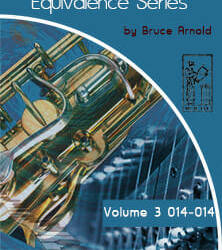
Harmonic and Melodic Equivalence V3
Use promo code:
buckbook
and get the course for $1.00 USD
Limited Time Offer
Harmonic and Melodic Equivalence V3
Add digital copy to cart - $19.99
Status: In stock, Digital book is available for immediate access.
Melodic Rotations Learning to Improvise More Based on the Composition
"Harmonic and Melodic Equivalence" is a series of books that will help you to develop many different musical skills simultaneously. The source materials for these books are exercises that contain two 3 note groupings, also called "trichords," that are manipulated in various ways. These exercises use many different types of harmonic and melodic ideas that can be superimposed over common chord progressions, scales and other musical situations. The exercises found in these courses are also great for singing and rhythm studies. Finally, the "Harmonic and Melodic Equivalence" course concentrates on the use of the three note pitch class sets (trichords) by pairing each trichord with another trichord with the same prime form. For instance, in this volume a Blues scale is divided up into two 3 note segments. Various exercises are presented that help you master this idea and examples can be seen below. This is an excellent way to get some new ideas from an old yet great scale.
Harmonic and Melodic Equivalence Exercises
This course is divided up into two sets of exercises written in treble and bass clef. The 1st set of exercises gets gradually harder but also more musical. Depending upon your musical skills you can start anywhere you want but for beginners I would recommend starting from the 1st exercise of the five. The 2nd set of exercises are called "Atomic Scales." These exercises are a technical exercise that really helps you to learn these ideas but also sound great as a melody right off the bat. There are 6 different types of "Atomic Scales" exercises in this course. You don't have to play every exercise in every key. But doing this will greatly increase the likelihood of you using it in real music in the future. Below is a listing of the exercises found in this course:
Closed position studies.
1st inversion studies.
2nd inversion studies.
Random combinations of closed position along with 1st and 2nd inversion.
Random combinations of closed position along with 1st and 2nd inversion with rhythmic displacement.
Atomic Scales Exercise 1
Atomic Scales Exercise 2
Atomic Scales Exercise 3
Atomic Scales Exercise 4
Atomic Scales Exercise 5
Atomic Scales Exercise 6
Explanation of 2nd Set of Exercises in Harmonic and Melodic Equivalence V3 Course
Below is an explanation for each set of the 6 different atomic scale exercises found in this course. Three octave sequences that move back and forth between the two 3 note groups are presented in six different configurations. These exercises are highly melodic and can be used verbatim as melodies when soloing. If we thought of the three notes as A,B,C then there would be six different ways to combine these notes. i.e. ABC, ACB, BAC, BCA, CAB and CBA. All exercises include MP3s as well as midi files so that you can hear and play these exercises at any tempo as well as versions in all 12 keys.
Three octave sequences that move back and forth between the two 3 note groups in the ABC sequence
Three octave sequences that move back and forth between the two 3 note groups in the ACB sequence
Three octave sequences that move back and forth between the two 3 note groups in the BAC sequence
Three octave sequences that move back and forth between the two 3 note groups in the BCA sequence
Three octave sequences that move back and forth between the two 3 note groups in the CAB sequence
Three octave sequences that move back and forth between the two 3 note groups in the CBA sequence
1st Set of Exercises in Harmonic and Melodic Equivalence V3 Course
Here are a few examples from the 1st set of exercises. A complete list of the different types of exercises can also be found below;
Closed Position Exercise

MP3 example
https://s3.amazonaws.com/media.muse-eek.com/mp3/HandMEV3/01_014_Degree_1_b2_3_2_b3_7_Closed_Position_Key_C.mp3
1st Inversion Exercise
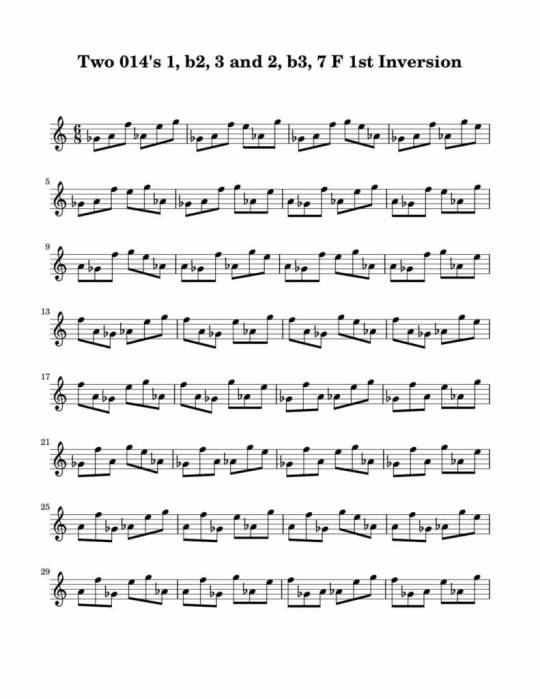
MP3 example
https://s3.amazonaws.com/media.muse-eek.com/mp3/HandMEV3/02_014_Degree_1_b2_3_2_b3_7_1st_Inversion_Key_F.mp3
2nd Inversion Exercise

MP3 example
https://s3.amazonaws.com/media.muse-eek.com/mp3/HandMEV3/03_014_Degree_1_b2_3_2_b3_7_2nd_Inversion_Key_Bb.mp3
Random combinations of closed position along with 1st and 2nd inversion.
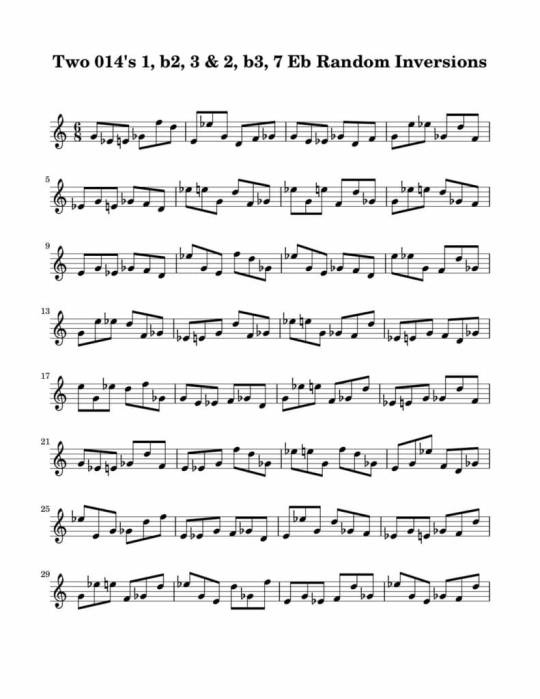
MP3 example
https://s3.amazonaws.com/media.muse-eek.com/mp3/HandMEV3/04_014_Degree_1_b2_3_2_b3_7_Random_Inversions_Key_Eb.mp3
Random combinations of closed position along with 1st and 2nd inversion and rhythm permutation

MP3 example
https://s3.amazonaws.com/media.muse-eek.com/mp3/HandMEV3/05_014_Degree_1_b2_3_2_b3_7_Random_Inv_Rhy_Key_Ab.mp3
2nd Set of Exercises in Harmonic and Melodic Equivalence V3 Course
Here are a few examples from the 2nd set of exercises.
Atomic Scales 1st Rotation

MP3 example
https://s3.amazonaws.com/media.muse-eek.com/mp3/HandMEV3/01_014_Degree_1_b2_3_2_b3_7_Atomic_Scale_Ex_1_Key_C.mp3
Atomic Scales 2nd Rotation

MP3 example
https://s3.amazonaws.com/media.muse-eek.com/mp3/HandMEV3/02_014_Degree_1_b2_3_2_b3_7_Atomic_Scale_Ex_2_Key_F.mp3
Atomic Scales 3rd Rotation

MP3 example
https://s3.amazonaws.com/media.muse-eek.com/mp3/HandMEV3/03_014_Degree_1_b2_3_2_b3_7_Atomic_Scale_Ex_3_Key_Bb.mp3
Atomic Scales 4th Rotation

MP3 example
https://s3.amazonaws.com/media.muse-eek.com/mp3/HandMEV3/04_014_Degree_1_b2_3_2_b3_7_Atomic_Scale_Ex_4_Key_Eb.mp3
Atomic Scales 5th Rotation

MP3 example
https://s3.amazonaws.com/media.muse-eek.com/mp3/HandMEV3/05_014_Degree_1_b2_3_2_b3_7_Atomic_Scale_Ex_5_Key_Ab.mp3
Atomic Scales 6th Rotation

MP3 example
https://s3.amazonaws.com/media.muse-eek.com/mp3/HandMEV3/06_014_Degree_1_b2_3_2_b3_7_Atomic_Scale_Ex_6_Key_Db.mp3
TOC in the Harmonic and Melodic Equivalence V3 Course:
How to Use This Course
Harmonic/Melodic Possibilities of Two 014s
Chord Possibilities of Two 014s
Other Groupings of the 1, b2, 2, b3, 3, 7 as a Scale
How to Think of the 014s Used in This Course
014 Daily Exercise-Atomic Scales
Thinking of the Trichords as Modes
Thinking of the Trichords as One Scale
C, Db, E and B, D, Eb as One Scale in All Keys
Additional Practice Ideas
Get Harmonic and Melodic Equivalence V3 Today!
Add digital copy to cart - $19.99
Status: In stock, Digital book is available for immediate access.
Additional Information for Harmonic and Melodic Equivalence V3:
Digital Edition 978-1-59489-337-7
One 11 page PDF explaining exercises, 5 different types of exercises, 328 pages of exercises in PDF format in treble and bass clef
MP3's and Midi files for all exercises.
12 MP3s from Tuba MetroDrone®
What people are saying:
From working with this book I have to say I'm fond of the 014 pitch class set. It reminds me of Thelonious Monk's music, which I love, but don't completely understand. This course has taken me one step closer to that understanding in that, it shows how to superimpose an 014 grouping to replace a dominant chord among other things. J. Ogland
014 is a very striking sound which took me a minute to comprehend. I've been looking for a way to change up my V7 to I7 chord voicings and melodies. While this book doesn't supply actual chord voicings it does give me tons of melodic lines. It also has a lot of charts that show how everything works in every key. J. Mannes
I own all these volumes and find each one to have it's own sound and application. I love exploring these new sounds which I've mostly been using as melodies but they could work as chords too. Really appreciate you guys putting out these books they are a gold mine of practical information on how to apply these modern concepts! W. Daniels
Hey Bruce, thanks for putting out this 014 book. I've been intrigued by the sound ever since I heard your composition "Numbers." To me these 014s are an eerie snake like sound that I'm really digging. U. Lucas
Read the full article
#12toneimprovisation#12tonejazz#12toneexercises#pitchclasssets#trichords#pitchclasssetimprovisation#HarmonicandMelodicV3
0 notes
Text
Harmonic and Melodic Equivalence V2

Harmonic and Melodic Equivalence V2
Use Promo Code:
buckbook
and get this course for 1 dollar USD.
Harmonic and Melodic Equivalence V2
Add digital copy to cart - $19.99
Status: In stock, Digital book is available for immediate access.
Melodic Rotations Learning to Improvise More Based on the Composition
"Harmonic and Melodic Equivalence" is a series of books that will help you to develop many different musical skills simultaneously. The source materials for these books are exercises that contain two 3 note groupings, also called "trichords," that are manipulated in various ways. These exercises use many different types of harmonic and melodic ideas that can be superimposed over common chord progressions, scales and other musical situations. The exercises found in these courses are also great for singing and rhythm studies. Finally, the "Harmonic and Melodic Equivalence" course concentrates on the use of the three note pitch class sets (trichords) by pairing each trichord with another trichord with the same prime form. For instance, in this volume C, Db, Eb and F#, G, A are both 013 pitch class sets because they both contain a 1/2 step and a minor 3rd within their interval structure. This is a great sequence because it uses six notes from a symmetrical diminished scale therefore you will find a ton of useful applications which are discussed in the course.
Harmonic and Melodic Equivalence Exercises
This course is divided up into two sets of exercises written in treble and bass clef. The 1st set of exercises gets gradually harder but also more musical. Depending upon your musical skills you can start anywhere you want but for beginners I would recommend starting from the 1st exercise of the five. The 2nd set of exercises are called "Atomic Scales." These exercises are a technical exercise that really helps you to learn these ideas but also sound great as a melody right off the bat. There are 6 different types of "Atomic Scales" exercises in this course. You don't have to play every exercise in every key. But doing this will greatly increase the likelihood of you using it in real music in the future. Below is a listing of the exercises found in this course:
Closed position studies.
1st inversion studies.
2nd inversion studies.
Random combinations of closed position along with 1st and 2nd inversion.
Random combinations of closed position along with 1st and 2nd inversion with rhythmic displacement.
Atomic Scales Exercise 1
Atomic Scales Exercise 2
Atomic Scales Exercise 3
Atomic Scales Exercise 4
Atomic Scales Exercise 5
Atomic Scales Exercise 6
Explanation of 1st Set of Exercises in Harmonic and Melodic Equivalence V2 Course
Below is an explanation for each set of the 6 different atomic scale exercises found in this course. Three octave sequences that move back and forth between the two 3 note groups are presented in six different configurations. These exercises are highly melodic and can be used verbatim as melodies when soloing. If we thought of the three notes as A,B,C then there would be six different ways to combine these notes. i.e. ABC, ACB, BAC, BCA, CAB and CBA. All exercises include MP3s as well as midi files so that you can hear and play these exercises at any tempo as well as versions in all 12 keys.
Three octave sequences that move back and forth between the two 3 note groups in the ABC sequence
Three octave sequences that move back and forth between the two 3 note groups in the ACB sequence
Three octave sequences that move back and forth between the two 3 note groups in the BAC sequence
Three octave sequences that move back and forth between the two 3 note groups in the BCA sequence
Three octave sequences that move back and forth between the two 3 note groups in the CAB sequence
Three octave sequences that move back and forth between the two 3 note groups in the CBA sequence
1st Set of Exercises in Harmonic and Melodic Equivalence V2 Course
Here are a few examples from the 1st set of exercises. A complete list of the different types of exercises can also be found below.
Closed Position Exercise

MP3 example
https://s3.amazonaws.com/media.muse-eek.com/mp3/HandMEV2/01_013_Degree_1_b2_b3_b5_5_6_Closed_Position_Key_C.mp3
1st Inversion Exercise

MP3 example
https://s3.amazonaws.com/media.muse-eek.com/mp3/HandMEV2/02_013_Degree_1_b2_b3_b5_5_6_1st_Inversion_Key_F.mp3
2nd Inversion Exercise

MP3 example
https://s3.amazonaws.com/media.muse-eek.com/mp3/HandMEV2/03_013_Degree_1_b2_b3_b5_5_6_2nd_Inversion_Key_Bb.mp3
Random combinations of closed position along with 1st and 2nd inversion.

MP3 example
https://s3.amazonaws.com/media.muse-eek.com/mp3/HandMEV2/04_013_Degree_1_b2_b3_b5_5_6_Atomic_Scale_Ex_4_Key__Eb.mp3
Random combinations of closed position along with 1st and 2nd inversion and rhythm permutation

MP3 example
https://s3.amazonaws.com/media.muse-eek.com/mp3/HandMEV2/05_013_Degree_1_b2_b3_b5_5_6_Random_Inv_Rhy_Key_Ab.mp3
2nd Set of Exercises in Harmonic and Melodic Equivalence V2 Course
Here are a few examples from the 2nd set of exercises.
Atomic Scales 1st Rotation

MP3 example
https://s3.amazonaws.com/media.muse-eek.com/mp3/HandMEV2/01_013_Degree_1_b2_b3_b5_5_6_Atomic_Scale_Ex_1_Key__C.mp3
Atomic Scales 2nd Rotation

MP3 example
https://s3.amazonaws.com/media.muse-eek.com/mp3/HandMEV2/02_013_Degree_1_b2_b3_b5_5_6_Atomic_Scale_Ex_2_Key__F.mp3
Atomic Scales 3rd Rotation

MP3 example
https://s3.amazonaws.com/media.muse-eek.com/mp3/HandMEV2/03_013_Degree_1_b2_b3_b5_5_6_Atomic_Scale_Ex_3_Key__Bb.mp3
Atomic Scales 4th Rotation

MP3 example
https://s3.amazonaws.com/media.muse-eek.com/mp3/HandMEV2/04_013_Degree_1_b2_b3_b5_5_6_Atomic_Scale_Ex_4_Key__Eb.mp3
Atomic Scales 5th Rotation

MP3 example
https://s3.amazonaws.com/media.muse-eek.com/mp3/HandMEV2/05_013_Degree_1_b2_b3_b5_5_6_Atomic_Scale_Ex_5_Key__Ab.mp3
Atomic Scales 6th Rotation

MP3 example
https://s3.amazonaws.com/media.muse-eek.com/mp3/HandMEV2/06_013_Degree_1_b2_b3_b5_5_6_Atomic_Scale_Ex_6_Key__Db.mp3
TOC in the Harmonic and Melodic Equivalence V2 Course:
How to Use This Course
Harmonic/Melodic Possibilities of Two 013's
Chord Possibilities of Two 013's
Rotations Starting on Every Eighth Note
Two 013's in Modal Playing
How to Think of the 013's Used in This Course
013 Daily Exercise-Atomic Scales
Thinking of the Trichords as Modes
Thinking of the Trichords as One Scale
C, Db, Eb and F#, G, A as One Scale in All Keys
Get Harmonic and Melodic Equivalence V2 Today!
Add digital copy to cart - $19.99
Status: In stock, Digital book is available for immediate access.
Additional Information for Harmonic and Melodic Equivalence V2:
Digital Edition 978-1-59489-332-2
One 8 page PDF explaining exercises, 5 different types of exercises, 328 pages of exercises in PDF format in treble and bass clef
MP3's and Midi files for all exercises.
12 MP3s from Tuba MetroDrone®
What people are saying:
This is my favorite Harmonic and Melodic Equivalence course so far. I use octatonic scales all the time and taking six notes from an octatonic scale and dividing them up into two 3 note groups is one of the coolest sounds. Thanks Bruce!! J. Ogland
Along with this book I also own the Bruce Arnold Composition Compilation. I would highly recommend working with both books because Mr. Arnold has written a lot of music that uses these various composition/improv techniques. Hearing them in use with real music makes all the difference! J. Loren
Boy Bruce these books contain some really great ideas for improvisation and they aren't hard to do either. I was making music out of this C, Db, Eb and F#, G and A within hours. Thanks for making these very informative books A. Randell
Bruce I can't thank you enough for the email correspondence to get me on the right track with these new books. I just couldn't wrap my head around the prime form pitch class set stuff and of course now that I understand it is seems simple. Such a powerful tool for organizing and seeing relationships. Thanks!! J. Williams
Read the full article
0 notes
Text
Harmonic and Melodic Equivalence V1

Harmonic and Melodic Equivalence V1
In order to help musicians that are stuck at home we are offering this course for 1 dollar for a limited time. The book is regularly 19.99 Use promo code: corona
Harmonic and Melodic Equivalence V1
Add digital copy to cart - $19.99
Status: In stock, Digital book is available for immediate access.
Melodic Rotations Learning to Improvise More Based on the Composition
"Harmonic and Melodic Equivalence" is a series of books that will help you to develop many different musical skills simultaneously. The source materials for these books are exercises that contain two 3 note groupings, also called "trichords," that are manipulated in various ways. These exercises use many different types of harmonic and melodic ideas that can be superimposed over common chord progressions, scales and other musical situations. The exercises found in these courses are also great for singing and rhythm studies. Finally, the "Harmonic and Melodic Equivalence" course concentrates on the use of the three note pitch class sets (trichords) by pairing each trichord with another trichord with the same prime form. For instance, C, Db, Eb and D, E, F are both 013 pitch class sets because they both contain a 1/2 step and a minor 3rd within their interval structure.
Harmonic and Melodic Equivalence Exercises
This course is divided up into five sets of exercises written in treble and bass clef. Each exercise gets gradually harder but also more musical. Depending upon your musical skills you can start anywhere you want but for beginners I would recommend starting from the 1st exercise. You don't have to play every exercise in every key. But doing this will greatly increase the likelihood of you using it in real music in the future. The five exercises found in this course are as follows:
Closed position studies.
1st inversion studies.
2nd inversion studies.
Random combinations of closed position along with 1st and 2nd inversion.
Random combinations of closed position along with 1st and 2nd inversion with rhythmic displacement.
Examples from the Harmonic and Melodic Equivalence V1 Course
Below is an explanation for each set of the 5 different exercises found in this course. All exercises include MP3s as well as midi files so that you can hear and play these exercises at any tempo as well as versions in all 12 keys.
Closed position studies are an excellent way to get a foothold into the sound of these two 3 note groups moving back and forth. Along with playing them on your instrument, I also recommend using a drone in the background to help you hear the key center. It is a good idea to sing through these melodies, again with a drone in the background. Any instrument could be used as a drone but I recommend using the MetroDrone® app or MP3's as your source. 12 MP3s from the MetroDrone® are included with this course. Initially you wouldn't have to play or sing any exercise in time but that would be your ultimate goal. Once you reach the level of playing or singing these melodies in time I highly recommend you get the full version of the MetroDrone® so that you can work at all tempos in all keys.
The 1st Inversion studies open up the 3 note group to a large melodic leap. While initially this might not seem very musical, later on when you work with levels 4 and 5 studies you will see these leaps are very useful in making a coherent melodic line. These leaps can also be a challenge to play and sing so they are an excellent source for developing this side of your musicianship. The singing of 1st inversion and the forthcoming 2nd inversion exercises helps you hear the 3 note group in any configuration and prepare you for how it will be found in real music.
The 2nd inversion studies completes the three possible ways to play the 3 notes groups within one octave. Like the 1st inversion they are excellent to develop your physical ability and singing these melodies will extend your technical and aural skills.
The 4th exercise where random combinations of closed position, 1st and 2nd inversion are used gets you much closer to how these melodies would sound when used with real music. The one drawback is the constant stream of eighth notes which would certainly need further editing to make consistent musical melodic lines. This 4th exercise is really just a preparation for the 5th exercise which will introduce rests. By introducing rests the melodies become much more musical but also much harder to play because of the shifting rhythms. This is why the 4th exercise is a good stepping stone for the 5th. Singing these melodies with a drone is also recommended.
The last level introduces syncopation to the random combinations of closed position, 1st and 2nd inversions. This is by far the most musical of the five exercises but also the most challenging. If you have good technical skills as well as sight reading chops, I recommend going to this exercise first, so that you can hear how the combination of C, Db, Eb and D, E, F will sound in a melodic line. Use the MetroDrone® or other jam tracks to explore how this combination sounds in different contexts.
Here are a few examples from the course. A complete list of the different types of exercises can also be found below.
Closed Position Exercise

At Slower Tempo
https://s3.amazonaws.com/media.muse-eek.com/mp3/HandMEV1/01_013_Key_C.mp3
At Faster Tempo
https://s3.amazonaws.com/media.muse-eek.com/mp3/HandMEV1/01_013_Key_C_Fast.mp3
1st Inversion Exercise

At Slower Tempo
https://s3.amazonaws.com/media.muse-eek.com/mp3/HandMEV1/02_013_Key_F.mp3
At Faster Tempo
https://s3.amazonaws.com/media.muse-eek.com/mp3/HandMEV1/02_013_Key_F_Fast.mp3
2nd Inversion Exercise

At Slower Tempo
https://s3.amazonaws.com/media.muse-eek.com/mp3/HandMEV1/03_013_Bb.mp3
At Faster Tempo
https://s3.amazonaws.com/media.muse-eek.com/mp3/HandMEV1/03_013_Bb_Fast.mp3
Random combinations of closed position along with 1st and 2nd inversion.

At Slower Tempo
https://s3.amazonaws.com/media.muse-eek.com/mp3/HandMEV1/04_013_Eb.mp3
At Faster Tempo
https://s3.amazonaws.com/media.muse-eek.com/mp3/HandMEV1/04_013_Key_Eb_Fast.mp3
Random combinations of closed position along with 1st and 2nd inversion and rhythm permutation

At Slower Tempo
https://s3.amazonaws.com/media.muse-eek.com/mp3/HandMEV1/05_013_Key_Ab.mp3
At Faster Tempo
https://s3.amazonaws.com/media.muse-eek.com/mp3/HandMEV1/05_013_Key_Ab_Fast.mp3
Exercises Found in the Harmonic and Melodic Equivalence V1 Course:
How to Use This Course
Harmonic/Melodic Possibilities of Two 013's
Chord Possibilities of Two 013's
Rotations Starting on Every Eighth Note
Two 013's in Modal Playing
How to Think of the 013's Used in This Course
Get Harmonic and Melodic Equivalence Today!
Add digital copy to cart - $19.99
Status: In stock, Digital book is available for immediate access.
Additional Information for Harmonic and Melodic Equivalence V1:
Digital Edition 978-1-59489-331-5
One 6 page PDF explaining exercises, 5 different types of exercises, 256 pages of exercises in PDF format in treble and bass clef
MP3's and Midi files for all exercises.
12 MP3s from Tuba MetroDrone®
What people are saying:
I'm looking forward to digging into these Harmonic and Melodic Equivalence courses. They are bit size windows into the use of 3 note groupings over many musical situations. I'm inspired already! J. Ogland
I own most of Mr. Arnold's pitch class set books. This series really goes to the heart of Mr. Arnold's explorations in this field. I like that it explores just one region at a time but also gives you enough information to dig deeper if you so desire. K. Franklin
This is one of the few places I've found where there are exercises that aren't just a series of eighth notes void of rhythm. While there are some exercises like that in this book the level 5 exercises incorporate rhythm which is essential in making musical sense out of these ideas. I also love the fact that there are midi files for every exercise. That is very helpful! W. Harris
Hey Bruce, greatly appreciate you including the bass clef versions of these exercises in the course. I hate it when you have to buy a separate book just to get the bass clef exericises. I play bass and guitar so you can see my dilemma. I love the ideas you present in this book. Real nuts and bolts applications of materials that are usually thought of as avant garde. Using 013's as a V7 to I progression. Brilliant! A. Wadsworth
Read the full article
0 notes